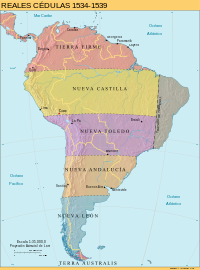Pedro Sánchez de la Hoz or Pedro Sancho de la Hoz (1514 in Calahorra, La Rioja – 1547 in Santiago de Chile)[1] was a Spanish merchant, conquistador and adelantado who served as secretary to Pizarro. In 1534 he obtained the rights of a capitulación de conquista south of the Straits of Magellan. He was appointed by Charles V, Holy Roman Emperor as an adelantado of the Governorate of Terra Australis in 1539.
Pedro Sancho de la Hoz | |
|---|---|
| 1st Adelantado of Terra Australis | |
| In office January 24, 1539 – August 2, 1540 | |
| Monarch | Charles I of Spain |
| Preceded by | Creation of the title |
| Succeeded by | Pedro de Valdivia |
| Personal details | |
| Born | 1514 Calahorra, Old Castile, Crown of Castile |
| Died | December, 1557 (aged 43) Santiago, Chile |
| Profession | Adelantado, chronicler, explorer and conquistador |
| Military service | |
| Allegiance | |
Sánchez de la Hoz, served as secretary to Pizarro in Peru during the conquest of Cuzco and wrote an account of the conquest of Peru.[2] While the original manuscript was lost, the work was preserved in Italian translation and has subsequently been translated to other languages, serving as a valuable account of both the Spanish conquest and Incan ethnography.[3] After some financial success, he returned to Spain and was granted leave by Emperor Charles V to return to the New World where he conflicted with rival conquistador Pedro de Valdivia over different grants to lands south of Peru. In 1547 Francisco de Villagra, one of Valdivia's men, had Sánchez de la Hoz executed for leading a rebellion.[4]

According to Argentina and Chile the capitulación granted to Sánchez de la Hoz proves the Spanish Empire had claims and an animus occupandi on the lands that would later be called Antarctica. Given that Chile and Argentina have historically successfully established their border based on the uti possidetis iuris principle of international law the Sánchez de la Hoz grant forms part of their arguments for territorial claims in Antarctica.[5]
References edit
- ^ Ochoa, J.M.G. (2003). Quién es quién en la América del descubrimiento: 1492–1600. Archivos Acento (in Spanish). Acento Editorial. p. 360. ISBN 978-84-483-0735-6. Retrieved May 15, 2018.
- ^ Surekha Davies (2016). Renaissance Ethnography and the Invention of the Human: New Worlds, Maps and Monsters. Cambridge University Press. pp. 231–232. ISBN 978-1-316-54612-3.
- ^ Pedro Sancho (1917) [1534]. Relación de la conquista del Perú [An Account of the Conquest of Peru]. Translated by Philip Ainsworth Means. The Cortes Society. pp. 5-7. OCLC 1004325010.
- ^ George Francis Scott Elliot (1907). Chile: Its History and Development, Natural Features, Products, Commerce and Present Conditions. C. Scribner's sons. pp. 30–32, 37. OCLC 5096493.
- ^ Prieto Larrain, M. Cristina (2004). "El Tratado Antártico, vehículo de paz en un campo minado". Revista Universum (in Spanish). 19 (1). University of Talca: 138–147. Retrieved 31 December 2015.